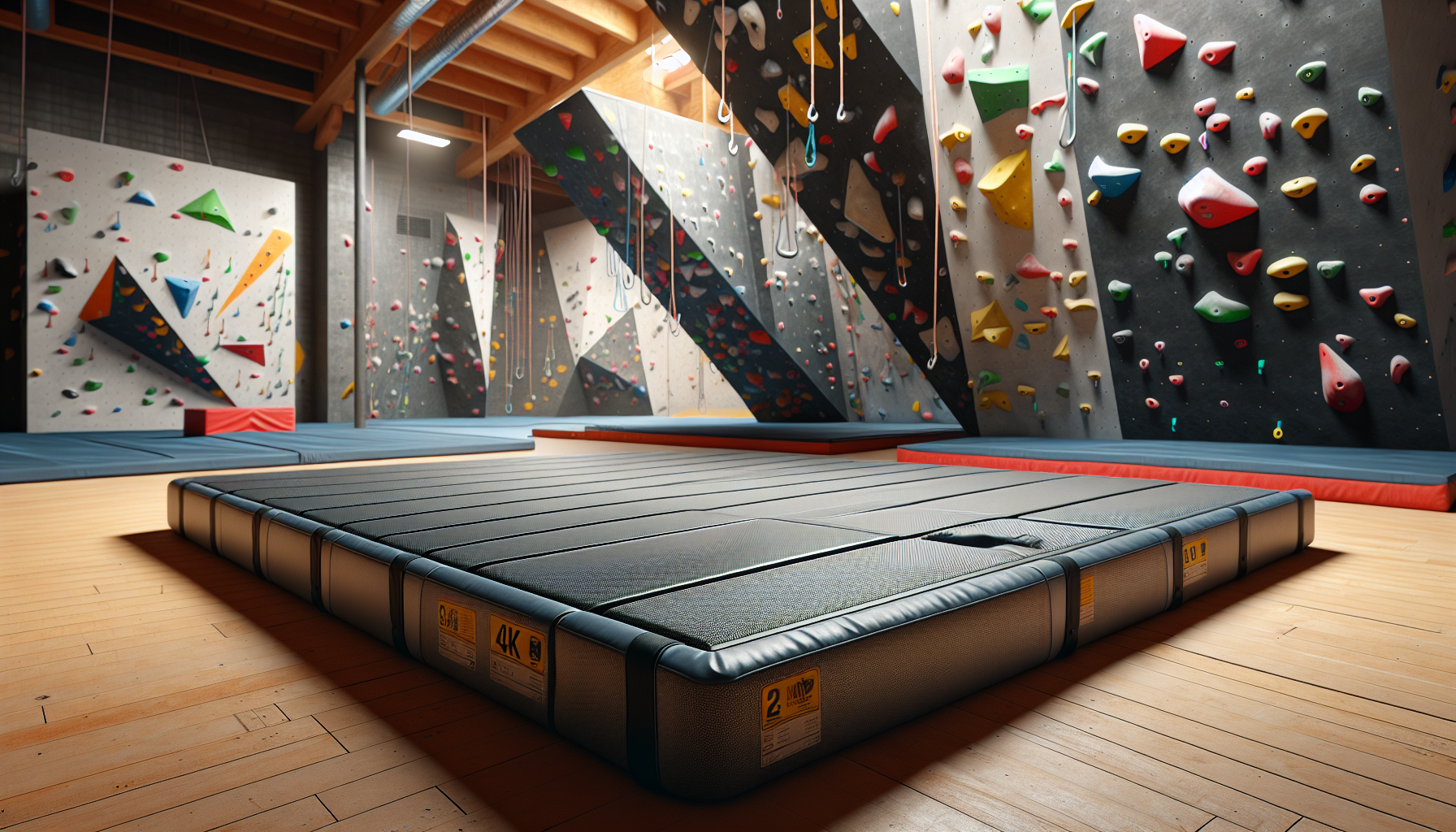
Experiencing the thrill of climbing indoors can be incredibly rewarding, but maintaining awareness around safety is crucial. According to the Climbing Business Journal, around 5 injuries occur per 1,000 visits to gyms focused on climbing.
Implementing precautions not only safeguards you but also elevates your overall adventure.
Vital equipment, such as crash pads, plays an essential role; these specialized mats are designed to cushion your falls and mitigate the risk of injury.
In addition, mastering effective fall techniques and utilizing proper spotting can drastically enhance your climbing practice. Actively participating in the climbing community allows you to stay informed about best practices and new techniques for safety.
Crash Pad Placement Techniques
Understanding how to position protective gear is vital for ensuring safer landings while climbing. Effective risk management is essential, as proper placement of padding can dramatically decrease injury risks during bouldering activities.
The first step involves assessing the climbing environment to pinpoint potential hazards and determine optimal landing zones.
Basic guidelines emphasize the importance of aligning pads directly beneath the fall zone, while utilizing multiple pads enhances injury prevention.
For taller climbs, stacking pads offers an extra layer of safety.
Involving spotters in the process can significantly improve safety by ensuring that pads are optimally positioned for a cushioned landing.
Ultimately, ongoing assessment and adaptation of techniques is crucial for maintaining an effective injury prevention strategy.

Importance of Spotting in Bouldering
Effective safety measures are essential in the sport of climbing, where the risks of falling are ever-present. When one is navigating challenging routes, a careful observer can significantly enhance falling awareness and provide peace of mind.
An adept individual who understands body positioning will anticipate the climber’s movements, preparing to catch them securely during a potential descent.
By directing the fall away from sharp edges or obstacles, spotters play a critical role in preventing injuries.
Clear communication between the climber and their supporter ensures that miscalculations are minimized, leading to smoother transitions. Maintaining vigilance contributes to effective chalk usage, which can improve grip strength and performance on tricky holds.
Trust fosters a strong bond; when climbers feel secure with their spotters, it transforms the climbing experience into a more enjoyable venture.
Proper body positioning, effective chalk usage, and adequate grip strength are essential for maintaining falling awareness and ensuring the proper use of safety gear.
Climbing Safety
- Proper body positioning can significantly reduce the risk of injury during falls.
- Effective communication between climbers and spotters is crucial for minimizing miscalculations during climbs.
- Using chalk appropriately improves grip strength, leading to better performance on challenging routes.
- Trust between climbers and spotters enhances the overall climbing experience and promotes safety.
Understanding Falling Awareness
Awareness during climbing activities plays a pivotal role in injury prevention and overall safety. By recognizing the importance of being alert during falls, climbers can better anticipate their landings and adjust their body positioning effectively.
Developing effective landing zones becomes crucial in minimizing impact and injury.
Engaging in awareness drills can enhance reflexes, allowing climbers to respond adeptly to unexpected situations.
When considering crash pad placement, it is vital to evaluate the terrain and potential hazards to ensure optimal safety.
Simulation drills provide climbers the opportunity to rehearse falls in a controlled environment, boosting their confidence and reaction times during real emergencies.
Gaining insights from experienced climbers significantly contributes to a deeper understanding of these fundamental techniques.
Essential Climbing Shoes Features
Selecting appropriate footwear is essential for anyone looking to excel in their climbing journey. The right climbing shoes can significantly improve grip comfort and overall bouldering performance.
Achieving an ideal fit is crucial, as shoes should be snug enough to enhance movement efficiency without causing discomfort.
A well-fitting shoe helps prevent blisters and allows for greater agility on challenging routes.
The type of rubber used also plays a pivotal role in your climbing experience.
Softer materials tend to offer superior traction, which is particularly beneficial for those utilizing climbing mats, while stiffer rubbers provide enhanced durability. Depending on your preferred climbing style, finding the right balance between these characteristics is vital.
In addition, the closure system of the shoes can greatly influence your convenience during climbs.
Velcro systems enable quick adjustments, ideal for fast-paced training programs, whereas lace-up options offer more customization for a snug fit. It’s also important to consider ankle support, tailored to your climbing style and the specific facility rules of your environment.
The comfort of the footbed is essential, especially for extended routes.
Proper cushioning minimizes fatigue, and lightweight designs can help maintain agility during intense climbs.
By prioritizing these features, you can enhance your overall experience on the wall.
| Feature | Importance |
|---|---|
| Fit | Prevents blisters and enhances movement efficiency |
| Rubber Type | Affects traction and durability based on climbing style |
| Closure System | Influences convenience and customization during climbs |
| Footbed Comfort | Minimizes fatigue on extended routes |
Injury Prevention Strategies for Climbers
Climbers must prioritize safety to enhance their performance and enjoyment on the rock. Focusing on the specific risks associated with bouldering allows enthusiasts to implement effective techniques that minimize potential injuries.
Effective warmup exercises, such as dynamic stretches, are essential for enhancing physical conditioning and flexibility, preparing the body for climbing.
Incorporating specific routines into your regimen can target key muscle groups, thereby reducing the likelihood of strains during your ascents.
Proper technique plays a critical role in ensuring safety.
Climbing partners should be trained in best practices for spotting, which can significantly improve overall protection against falls. Committing to continuous education about ascent techniques fosters safer climbing habits and reinforces mental preparation for challenges ahead.
Navigating Gym Etiquette for Safety
Creating a comfortable and enjoyable environment in climbing gyms is vital for everyone involved. Understanding the importance of gym rules and etiquette plays a significant role in maintaining a safe atmosphere for all participants.
Awareness of your surroundings is essential, as it allows for proper safety checks and helps prevent accidents while climbing.
Always yield the right-of-way to active climbers, giving them ample space to navigate their routes.
Clear communication with climbing partners should be prioritized, as expressing your intentions helps minimize misunderstandings and promotes ascent progression. Equipment must be used appropriately, including crash pads during bouldering, to ensure collective safety for everyone.
It’s courteous to respect the time others spend waiting for popular routes, which fosters a positive environment. Engaging with climbing coaches can also provide valuable guidance and enhance your skills, ultimately prioritizing safety and the well-being of the climbing community.
Creating a Safe Climbing Gym Environment
- Proper awareness and adherence to gym rules can reduce the risk of accidents by up to 50%.
- Effective communication among climbing partners decreases the likelihood of misunderstandings and enhances safety.
- Using equipment correctly, such as crash pads, has been shown to significantly lower injury rates in bouldering activities.
- Respecting others’ time for routes fosters a more positive and cooperative gym culture, improving the overall experience for all climbers.
Enhancing Grip Strength for Better Control
Strong control over climbing holds is essential for improved performance and enhanced safety while navigating challenging routes. Mastering this physical ability can significantly influence overall stability, reducing the likelihood of slips and supporting safer landings.
Regular training of grip strength not only bolsters climbing sequences but also prepares climbers for unexpected situations.
Engaging in exercises such as hangboarding or squeezes effectively elevates grip power while simultaneously sharpening injury response techniques.
Psychological readiness plays a critical role, as a confident climber is less prone to hesitation, which diminishes the chances of accidents. With consistent practice, significant improvements across these facets naturally occur over time.
Adopting Effective Emergency Procedures
In high-risk activities like bouldering, the ability to manage unexpected scenarios is vital for safety. Recognizing risks and making informed decisions about route difficulty is the first step towards effective safety outcomes.
Climbers must diligently assess their skills before tackling challenging climbs to mitigate potential hazards.
Preparation is paramount in emergency situations.
A well-stocked first aid kit and a clear facility layout for communication can be lifesaving during an incident.
Regular safety briefings should illuminate the location of emergency exits and clarify each team member’s role during unforeseen events.
Prioritizing response training enhances team members’ skills and confidence in dire situations. Engaging in workshops that focus on climbing technique and creating mock scenarios promotes preparedness and bolsters team dynamics, ensuring everyone knows their responsibilities when it matters most.
Post-incident evaluations are essential for growth.
Conducting comprehensive debriefs fosters an environment of learning, allowing teams to integrate feedback and refine established protocols, which leads to continued improvement in performance and safety.
For further insights on emergency protocols specific to bouldering, a variety of resources are accessible. Regular equipment inspections and a thorough understanding of responsibilities are crucial for maintaining a safe climbing environment.
It is essential to consider the facility layout, incorporate performance tips, enhance strength training, refine climbing technique, and assess route difficulty for optimal results.
Safety in Bouldering
- Regular risk assessment significantly lowers the likelihood of injury during climbs.
- Having a comprehensive first aid kit can greatly improve outcomes in emergency situations.
- Structured training programs enhance team dynamics and ensure that all members understand their roles during emergencies.
- Post-incident evaluations facilitate continuous improvement in safety protocols and climbing performance.





